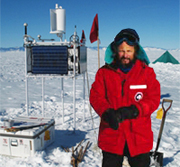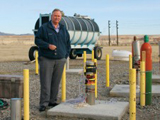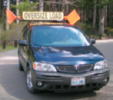


ARIANNA, a proposed array of detectors for capturing the most energetic cosmic rays, is being tested in Antarctica with a prototype station built last December on the Ross Ice Shelf by a Berkeley Lab team. By detecting neutrino-generated signals bounced off the interface of water and ice beneath the shelf, scientists hope to pinpoint the still unidentified sources of ultra-high-energy cosmic rays. More>
 [Miller-McCune] A ribbon of blacktop lined with telephone poles is the only human signature beyond the checkpoint at Hanford Site, the former nuclear production plant in southeastern Washington. Today, Hanford is the site of the “world’s largest environmental cleanup project.” Terry Hazen, a Berkeley Lab earth scientist, follows a long line of cleanup specialists trying to decontaminate the land. Hazen plans to cultivate an army of microbial janitors that will use evolved alchemy to convert hexavalent chromium into chromium III, a benign form of the element. More>
[Miller-McCune] A ribbon of blacktop lined with telephone poles is the only human signature beyond the checkpoint at Hanford Site, the former nuclear production plant in southeastern Washington. Today, Hanford is the site of the “world’s largest environmental cleanup project.” Terry Hazen, a Berkeley Lab earth scientist, follows a long line of cleanup specialists trying to decontaminate the land. Hazen plans to cultivate an army of microbial janitors that will use evolved alchemy to convert hexavalent chromium into chromium III, a benign form of the element. More>
 People: EETD’s Cairns Selected as Fellow of Electrochemistry Society
People: EETD’s Cairns Selected as Fellow of Electrochemistry SocietyElton Cairns, with the Lab’s Environmental Energy Technologies Division (EETD), has been selected as a Fellow of the International Society of Electrochemistry. Cairns’ research has covered a wide range of electrochemical energy conversion technologies, including the first fuel cells in space (Gemini Program), direct hydrocarbon fuel cells, high-temperature molten salt cells, zinc-nickel oxide cells for electric vehicles, lithium ion cells, lithium-sulfur cells, and electrocatalysts for direct methanol fuel cells. He will be inducted at the society's annual meeting in France in September.
 The numerous construction projects taking place at the Lab mean a lot of truck traffic on the Hill. Any trucks 40 feet long or more traveling through the Lab require a pilot-car escort, a service provided by the Lab's Pilot/Escort Group. These cars are identified by flags on the roofs. To improve safety during these trips, drivers and pedestrians should let the truck and pilot cars continue along their route. Do not try to pass or pull in between pilot cars and the truck.
The numerous construction projects taking place at the Lab mean a lot of truck traffic on the Hill. Any trucks 40 feet long or more traveling through the Lab require a pilot-car escort, a service provided by the Lab's Pilot/Escort Group. These cars are identified by flags on the roofs. To improve safety during these trips, drivers and pedestrians should let the truck and pilot cars continue along their route. Do not try to pass or pull in between pilot cars and the truck.
From an orientation for international employees to a Fidelity workshop on managing your online account, the HR Benefits department hosts a number of events to help staff manage their work and life. To assist in tracking upcoming events, the department produces a monthly calendar, and the May edition is now available.
Today at Berkeley Lab encourages comments, suggestions, and story ideas. Please send them here.
TABL is produced by Public Affairs' Communications Group